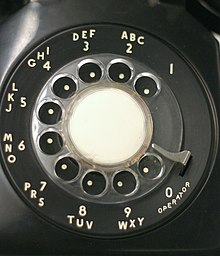
Back مزول Arabic Disc de marcar Catalan Rotační číselnice Czech Nummernschalter German Disco de marcar Spanish شمارهگیری چرخشی Persian Cadran téléphonique French טלפון חוגה HE ダイヤル#電話機のダイヤル Japanese 로터리 다이얼 Korean
This article needs additional citations for verification. (February 2015) |

A rotary dial is a component of a telephone or a telephone switchboard that implements a signaling technology in telecommunications known as pulse dialing. It is used when initiating a telephone call to transmit the destination telephone number to a telephone exchange.
On the rotary dial, the digits are arranged in a circular layout, with one finger hole in the finger wheel for each digit. For dialing a digit, the wheel is rotated against spring tension with one finger positioned in the corresponding hole, pulling the wheel with the finger to a stop position given by a mechanical barrier, the finger stop. When released at the finger stop, the wheel returns to its home position driven by the spring at a speed regulated by a governor device. During this return rotation, an electrical switch interrupts the direct current (DC) of the telephone line (local loop) the specific number of times associated with each digit and thereby generates electrical pulses which the telephone exchange decodes into each dialed digit. Thus, each of the ten digits is encoded in sequences to correspond to the number of pulses; thus, the method is sometimes called decadic dialing. Pulse count dialing is a digital addressing system which uses decimal pulse count modulation. The typical average baud rate is 10 bits per second, though the system will usually accept from about 9 through 13 pulses per second, a requirement due to variations in the rotary dial mechanism governor speed.
This dialing method is the world's first mass scale digital addressing system. It is sometimes erroneously referred to as an analog system due to some individuals' beliefs that mechanical and old are synonyms for analog. However, like the telegraph, which is also mechanical and digital, and which uses both pulse count and pulse width modulation for communicating, pulse dialing is a digital communication method used for addressing telephone subscribers.
The first patent for a rotary dial was granted to Almon Brown Strowger on November 29, 1892, but the commonly known form with holes in the finger wheel was not introduced until about 1904.[citation needed] While used in telephone systems of the independent telephone companies, rotary dial service in the Bell System in the United States was not common until the early 1920s.[1]
From the 1960s onward, the rotary dial was gradually supplanted by push-button telephones, first introduced to the public at the 1962 World's Fair under the trade name Touch-Tone (DTMF). Touch-tone technology primarily used a keypad in the form of a rectangular array of push-buttons. Although no longer in common use, the rotary dial's legacy remains in the verb "to dial (a telephone number)".
- ^ Roberts, William Lee. "A look at the evolution of the Dial Telephone". Retrieved 15 January 2016.
© MMXXIII Rich X Search. We shall prevail. All rights reserved. Rich X Search